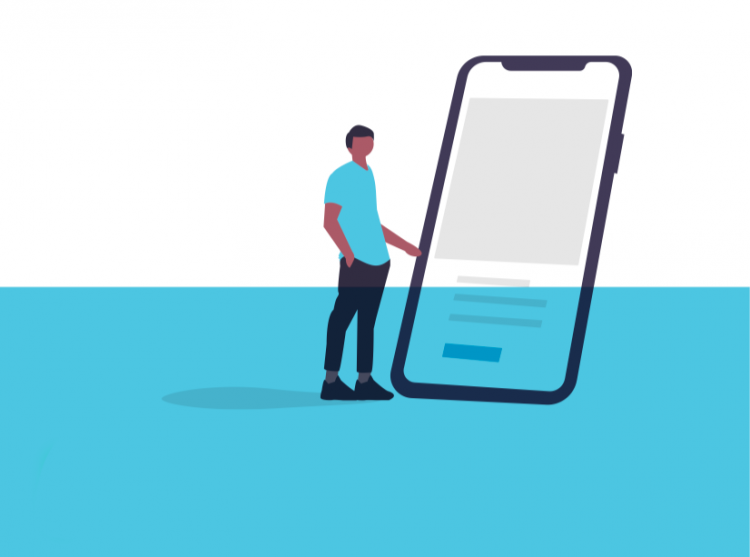How businesses leverage mobile applications
22.05.2023
367

Why do companies from different industries create their own services?
Using mobile technology, companies aim to automate processes, simplify employee and partner workflows, attract new customers, and increase the share of mobile sales.
It’s a common fact that the pandemic has brought about significant trends in the retail industry that continue to shape its future. Thus, the share of online shoppers has doubled in the last 5 years.
In 2019, every 3rd order was placed from a smartphone.
53% of orders placed from a smartphone are made through the application, the share of mobile browsers is decreasing.
The conversion rate into a purchase through the app is 3 times higher than from the mobile site.
31% of users only used a smartphone to search for products.
In fact, app customers are more loyal. They spend 37% more than non-app customers with the same retailer, buy 33% more frequently, and buy 34% more items.
We receive frequent inquiries from clients in retail, e-commerce, education, healthcare, construction, and industrial sectors. Our experience working with such clients is particularly notable.
Here’s why they invest in mobile services.
Retail
The application helps sellers of goods and services retain customers and optimize employee workflows.
Loyalty system
Large retail chains, small workshops, restaurants, and barbershops strive to study their existing customers, engage and retain them rather than chase new ones. To achieve this, companies are moving away from plastic cards and transferring their loyalty systems to smartphones.
84% of shoppers make impulsive purchases. With a convenient mobile loyalty system, this figure increases.
Usually, Mike goes to the appliance store to buy headphones for himself. He sees a toaster — just like his acquaintance wanted. Today, there is a 25% discount on this toaster for loyalty cardholders. Mike takes the headphones, the toaster, and heads to the checkout. When the cashier asks for the loyalty card, the young man realizes that he forgot it at home. Mike decides to give up on the toaster and buy it next time when he brings his plastic card.
On mobile, the customer loyalty card is always at hand, in the smartphone app. It is impossible to forget it at home, but you can still get a good discount on the desired item. Just open the app and show the barcode to the cashier — the purchase price will automatically decrease.
Streamlining internal processes
Mobile automation of business processes is a great opportunity to simplify daily and repetitive tasks.
Usually, a sales representative or manager spends about 65% of their working time on data entry and other minor actions that do not directly contribute to profitability.
On mobile, the application automates routine operations. Once a person enters data into the mobile app, it is transmitted to Google Docs or CRM. This saves the employee time that they would normally spend on multiple entries on different platforms — allowing them to be more active in tasks that generate revenue for the company.
Large retailers usually have a team of analysts who test applications, evaluate user scenarios and new features, and provide feedback to developers on what needs to be improved for even better usability. Smaller companies cannot afford such a setup as it is costly.Rustam Muhamedyanov, CEO of WINFOX
E-commerce
Companies in this industry often use mobile services to stand out among competitors and attract user attention.
Usually, Kate wants to buy a writing desk. She takes her smartphone, enters a search query in the mobile browser, and sees multiple links with offers. She clicks on them, browses through products, and compares offers from different sellers. This month, you didn’t run any contextual advertising, so you didn’t appear in the top search results. Kate didn’t remember you and ended up purchasing the desk from your competitors.
On mobile, last year Kate bought a wardrobe and installed your mobile application. When she needed a desk, she immediately thought of you, tapped on the app icon, and found what suited her. Within ten minutes, she placed an order without even considering searching for other options in the mobile browser.
By opening the mobile application, the customer interacts only with you – there is no competition for their attention and money.
Education
Those who work with students constantly need to use different sources of information, devices, and gadgets. The application offers a seamless user experience and saves time on repetitive tasks.
Usually, a school teacher marks attendance in a journal, then transfers this data to an Excel spreadsheet on a computer. At the end of each month, the teacher prepares individual reports for each student and manually sends them via email to parents.
On mobile, the teacher marks attendance in the mobile application. This data is automatically transferred to the school’s record-keeping system and added to the reporting, which is sent to parents of each student at the designated time. Instead of multiple actions, the teacher only needs to mark attendance — everything else happens without their involvement.
Medicine
Mobile makes clinics more modern and customer-oriented. A medical institution that has a mobile application offers patients a more convenient appointment booking system.
Usually, when Antony had a fever, he decided to schedule an appointment with a doctor. After finding the clinic’s phone number, Antony couldn’t reach them on the first try. It was only closer to the evening that he managed to get through, but the administrator informed him that appointments for the next day were already full. The young man had to schedule an appointment for the following day and in the meantime, resort to self-treatment.
On mobile, Antony took his smartphone, opened the clinic’s application, and booked an appointment online. The app displays the up-to-date schedule of doctors, allowing him to view their profiles and expertise, choose a suitable specialist, and select a convenient appointment time. No need to make phone calls at all.
Construction
For construction companies and developers, a mobile application is a way to retain customers and guide them towards a purchase.
Typically, a developer starts constructing a new residential complex and needs to sell the apartments, preferably as quickly as possible. They create a landing page, invest a couple of million in advertising, generate some expensive leads, and then work with them over the phone. However, people are not always ready to buy an apartment immediately; they need periodic reminders and more effective methods than just phone calls from a call center.
In the mobile app, alongside the landing page, developers can provide an application. Once users install the app, the developer can stay in constant contact with them. The company can send push notifications with discounts, invite users to view the apartments, and show live video streams from the construction site. Furthermore, they can analyze how users react to these messages and make them more subtle and valuable. This approach will be more appealing to potential buyers compared to interacting with a sales manager.
Industry
Enterprises utilize mobile applications for dispatching and real-time monitoring, enabling employees to remotely manage the engineering systems of one or multiple facilities.
Usually: The chief electrician at the factory needs to determine the optimal timing for scheduled maintenance of electrical panels in different workshops. To do so, they have to communicate with subordinates, gather data about the equipment, and input it into a computer program to calculate the optimal start date for the work.
On mobile: Employees in the workshops use an application to regularly update information about the electrical panels. Through the app, they scan the panel’s code, mark the date of maintenance work, and record the specific repairs conducted. This data is stored on the enterprise’s server or in the cloud, and it can be accessed in a unified report. The chief electrician only needs to open the report in the accounting software or on their smartphone to learn about the status of all panels at the factory.
Briefly
Companies from different industries use mobile services to solve various tasks, from automating routine actions to outperforming competitors. You can either follow the established trend or create your own. In any case, it is important to understand what factors affect the cost of a mobile application and whether it is possible to save some money on development. We will discuss this in the next article.
To assist those who have decided to develop their own mobile service, we have written a book titled «Mobile App for Business: What Clients Need to Know.» In this book, we have endeavored to provide answers to the most frequently asked questions from our clients. This book does not contain vague advice like «How to create an app in three simple steps.» Instead, it offers the experience accumulated by WINFOX over five years in the mobile development market, practical examples, and a guide to action. Those who approach our studio receive a printed version of the book. Rustam Muhamedyanov, CEO of WINFOX
Подпишись на рассылку
Other article
11.01.2016
4536
Как создать приложение для детей?
Главная составляющая хорошего UX — интуитивно-понятная цифровая среда, которая, по выражению дизайнера Стива Круга, не должна заставлять пользователя думать....
11.11.2016
2998
3 причины использовать Swift в разработке приложений для iOS/OS X
Исследование специфики Swift и изучение того, как использовать этот язык программирования по максимуму, поможет превратить разрабатывающийся проект в историю...


